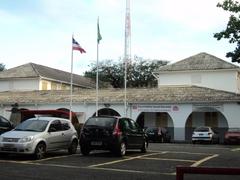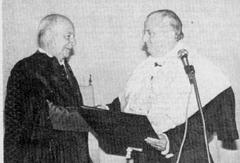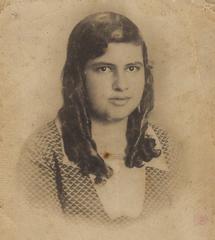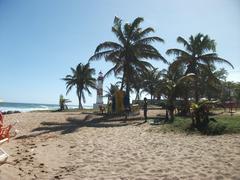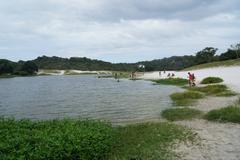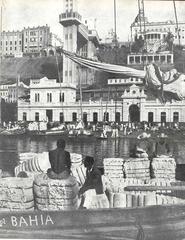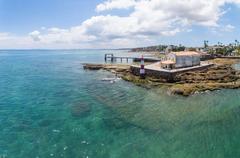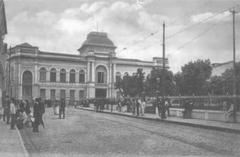
Ilê Axé Opó Afonjá: Hours, Tickets, and Complete Guide to a Salvador Historical Site
Date: 04/07/2025
Introduction
Ilê Axé Opó Afonjá is not only one of Brazil’s most important Candomblé terreiros (temples), but also a living testament to the resilience and creativity of Afro-Brazilian communities. Established in 1910 by Mãe Aninha (Eugênia Anna dos Santos), this sacred site in Salvador, Bahia, preserves the Yoruba religious tradition brought from West Africa, serving as a vibrant center for spiritual practice, education, cultural preservation, and social justice (iBahia, salvadorbahiabrazil.com). Spanning nearly 39,000 square meters in the Cabula neighborhood, Ilê Axé Opó Afonjá’s grounds blend lush native vegetation with temples, schools, a museum, and a library, creating an immersive experience for all who visit.
As a nationally recognized heritage site protected by the Instituto do Patrimônio Histórico e Artístico Nacional (IPHAN), the terreiro is a beacon of Afro-Brazilian identity and resilience, hosting festivals, educational initiatives, and guided tours that welcome visitors to engage with its rich legacy (iBahia).
Table of Contents
- Foundation and Historical Development
- Leadership and Legal Recognition
- Cultural and Educational Initiatives
- Architectural Features
- Festivals and Public Events
- Visiting Information: Hours, Tickets, Accessibility
- Visitor Tips and Etiquette
- Frequently Asked Questions (FAQ)
- Summary and Conclusion
- References and Further Reading
Foundation and Historical Development
Ilê Axé Opó Afonjá was founded in 1910 by Mãe Aninha, following a split from the historic Casa Branca do Engenho Velho. The terreiro’s name means “House of the Power Sustained by Xangô,” referencing the orixá of thunder and justice, and anchoring the temple within the Ketu (Yoruba) Candomblé tradition (Wikipedia). Its grounds, carefully chosen for their natural elevation, encompass sacred temples, educational facilities, residences, and one of the last preserved green spaces in Cabula (iBahia).
Candomblé itself, developed by enslaved Africans and their descendants, provided spiritual survival and cultural affirmation amid oppression. Ilê Axé Opó Afonjá has been central to this legacy as both sanctuary and cultural stronghold (salvadorbahiabrazil.com).
Leadership and Legal Recognition
Mãe Aninha’s influence extended to the national stage—her advocacy contributed to Decree 1.202 (1939), which curtailed repression of Candomblé and capoeira in Brazil, affirming religious freedom (iBahia). After her death, the terreiro was led by Mãe Senhora, Mãe Ondina, and Mãe Stella de Oxóssi, each expanding its social and educational mission. The “Corpo dos Obás de Xangô,” a council of prominent cultural figures, supports the terreiro’s leadership and connects it with broader society (Geledés).
On July 28, 2000, Ilê Axé Opó Afonjá was recognized as a national heritage site by IPHAN, ensuring the protection of its structures and traditions for future generations (iBahia).
Cultural and Educational Initiatives
Ilê Axé Opó Afonjá has always been more than a religious center. It operates:
- Escola Eugênia Anna dos Santos (Irê Ayó): A pioneering school integrating Yoruba language, Candomblé values, and Afro-Brazilian history into its curriculum, nationally recognized for its innovative approach (source).
- Museu Ilê Ohun Lailai (“House of Ancient Things”): Founded by Mãe Stella de Oxóssi, this museum preserves ritual objects, clothing, musical instruments, and photographs—providing tangible links to Afro-Brazilian heritage (source).
- Biblioteca do Axé: A specialized library with collections focused on African and Afro-Brazilian culture and history.
- Workshops and Artistic Programs: Regular offerings in drumming, dance, and crafts, open to locals and visitors (Tripjive).
Through these initiatives, the terreiro combats racial discrimination, fosters cultural pride, and supports community development.
Architectural Features
The terreiro’s architecture and grounds reflect both spiritual and ecological priorities:
- Casa de Xangô: The main temple, modest in appearance but central to ritual life (Wikipedia).
- Sanctuaries of Oxalá and Iemanjá: Flanking buildings dedicated to peace and motherhood, each with unique decor (Na Bahia).
- Sacred Fountain of Oxum: Honoring the orixá of fresh water, love, and fertility.
- Casa do Alaká: Workshop preserving West African textile traditions (Salvador da Bahia).
- Bronze statue of Iansã: Created by Tati Moreno, symbolizing Afro-Brazilian artistry (Na Bahia).
Approximately two-thirds of the grounds remain dense native vegetation, underscoring the terreiro’s ecological significance (Wikipedia).
Festivals and Public Events
Ilê Axé Opó Afonjá hosts some of Salvador’s most vibrant festivals—openings into the spiritual and artistic heart of the community:
- Festival of Oxóssi: Celebrated during Corpus Christi, with processions, music, and offerings (Wikipedia).
- Festival of Xangô: Held in late June, featuring dance, drumming, and the preparation of amaralá, a ritual dish.
- Other Orixá Festivals: Honoring Iemanjá, Oxum, Iansã, and others, with ceremonies, music, and communal feasting (Na Bahia).
- Alaiandê Xirê – Semana Cultural da Herança Africana: An international week of music, workshops, and seminars, promoting dialogue on African heritage (Wikipedia PT).
Visitor Guidelines for Festivals:
- Wear white or light-colored clothing; avoid black.
- Photography and videography during ceremonies are prohibited.
- Maintain silence and respect during rituals.
- Check official social media for updated festival dates.
Visiting Information: Hours, Tickets, Accessibility
- Hours: Museum open Tuesday–Sunday, 9:00 AM–5:00 PM. Library open Monday–Friday, 8:00 AM–4:00 PM. Festivals usually start at 7:00 PM.
- Tickets: General admission is free; donations are appreciated. Guided tours, recommended for deeper insight, may have a modest fee (typically R$30–R$60).
- Accessibility: Some terrain is uneven; limited wheelchair access. Contact the terreiro in advance for accommodations.
- Location: Rua Direta de São Gonçalo do Retiro, 557, Cabula, Salvador (Na Bahia). Taxis or ride-share from central Salvador are recommended.
Visitor Tips and Etiquette
- Dress modestly (white preferred); cover shoulders and knees.
- Always ask permission before photographing, especially during ceremonies.
- Observe silence during rituals and follow all staff instructions.
- Donations help support the terreiro’s educational and cultural programs.
- Plan daytime visits for the museum and grounds; evenings for festivals.
Frequently Asked Questions (FAQ)
Q: Are tickets required?
A: General admission is free; some guided tours or workshops may have a fee.
Q: What are the visiting hours?
A: Museum: Tue–Sun, 9:00 AM–5:00 PM. Festivals: typically from 7:00 PM.
Q: Can I attend ceremonies?
A: Many festival events are open to visitors, but some rituals are for initiates only. Book in advance and respect terreiro guidelines.
Q: Is the site family-friendly?
A: Yes, but check in advance regarding appropriateness for young children during ceremonies.
Q: Is Ilê Axé Opó Afonjá accessible for visitors with disabilities?
A: Some areas are challenging; contact the terreiro for specific accommodations.
Summary and Conclusion
Ilê Axé Opó Afonjá stands at the crossroads of spirituality, culture, and resistance in Salvador, Bahia. Its historical significance, educational initiatives, and vibrant festivals make it a must-visit for those seeking to understand Afro-Brazilian heritage. By respecting the terreiro’s customs and participating in authorized tours and events, visitors contribute to the preservation of this living monument and gain a profound appreciation of its enduring legacy (Geledés, iBahia, Wikipedia, Na Bahia, salvadorbahiabrazil.com).
Plan your visit today and immerse yourself in the living heart of Salvador’s Afro-Brazilian culture. For updates, check the official Ilê Axé Opó Afonjá social media and download the Audiala app for guided tours and event alerts.
References and Further Reading
- iBahia Article on Ilê Axé Opó Afonjá
- Salvadorbahiabrazil.com: Candomblé in Salvador
- Wikipedia: Ilê Axé Opó Afonjá
- Na Bahia: Visit Ilê Axé Opó Afonjá
- Tripjive: Candomblé Cultural Tours
- Geledés: Mãe Aninha and Leadership
- Escola Eugênia Anna dos Santos Project
- Mãe Stella de Oxóssi Biography





